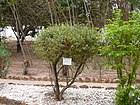Note: This is a project under development. The articles on this wiki are just being initiated and broadly incomplete. You can Help creating new pages.
Difference between revisions of "Lawsonia inermis - Mendhika"
(→List of Ayurvedic medicine in which the herb is used) |
(→References) |
||
| Line 72: | Line 72: | ||
<ref name="Leaf">[https://www.herbal-supplement-resource.com/henna-herb-uses.html "plant description"]</ref> | <ref name="Leaf">[https://www.herbal-supplement-resource.com/henna-herb-uses.html "plant description"]</ref> | ||
| + | <ref name="Ayurvedic preparations">[https://easyayurveda.com/2016/08/09/henna-mehndi-benefits-usage-research-side-effects/ "Ayurvedic preparations"]</ref> | ||
<ref name="How to plant/cultivate">[http://tropical.theferns.info/viewtropical.php?id=Lawsonia+inermis "Cultivation Details"]</ref> | <ref name="How to plant/cultivate">[http://tropical.theferns.info/viewtropical.php?id=Lawsonia+inermis "Cultivation Details"]</ref> | ||
Revision as of 18:02, 7 June 2019
Henna is a flowering plant and the sole species of the Lawsonia genus.
Contents
- 1 Uses
- 2 Parts Used
- 3 Chemical Composition
- 4 Common names
- 5 Properties
- 6 Habit
- 7 Identification
- 8 List of Ayurvedic medicine in which the herb is used
- 9 Where to get the saplings
- 10 Mode of Propagation
- 11 How to plant/cultivate
- 12 Commonly seen growing in areas
- 13 Photo Gallery
- 14 References
- 15 External Links
Uses
Bleeding, Nerve deseases, Amoebic dysentery, Wounds, Skin eruptions, Ulcers, Pimples, Diarrhea, Sore throats
Parts Used
Chemical Composition
The major components were ethyl hexadecanoate (24.4%), (E)-methyl cinnamate (11.4%), isocaryophyllene (8.1%), (E)-β-ionone (5.8%) and methyl linolenate (4.1%).[1]
Common names
| Language | Common name |
|---|---|
| Kannada | goranta, gorante |
| Hindi | hena, henna |
| Malayalam | mail-anschi, mailanci |
| Tamil | aivanam, aivanam |
| Telugu | goranta, gorata |
| Marathi | NA |
| Gujarathi | NA |
| Punjabi | NA |
| Kashmiri | NA |
| Sanskrit | dvivranta, kokadanta |
| English | henna |
Properties
Reference: Dravya - Substance, Rasa - Taste, Guna - Qualities, Veerya - Potency, Vipaka - Post-digesion effect, Karma - Pharmacological activity, Prabhava - Therepeutics.
Dravya
Rasa
Guna
Veerya
Vipaka
Karma
Prabhava
Habit
Identification
Leaf
| Kind | Shape | Feature |
|---|---|---|
| Simple | Henna is a thorny evergreen shrub that can reach up to 6.0 m in heightThe leaves are divided into 3-6 toothed leaflets, with smaller leaflets in between |
Flower
| Type | Size | Color and composition | Stamen | More information |
|---|---|---|---|---|
| Unisexual | 2-4cm long | Yellow | 5-20 | The fragrant flowers are whitish or pink to brick red and sit in a pyramid-shaped inflorescence |
Fruit
| Type | Size | Mass | Appearance | Seeds | More information |
|---|---|---|---|---|---|
| simple | 7–10 mm | The fruit is a blue-black berry | single | {{{6}}} |
Other features
List of Ayurvedic medicine in which the herb is used
Where to get the saplings
Mode of Propagation
How to plant/cultivate
A plant of the dry to moist tropics and subtropics, where it is found at elevations up to 2,000 metres[4]
Commonly seen growing in areas
Warmer parts of South and North America, Meadows, Borders of forests and fields.
Photo Gallery
References
External Links
- Ayurvedic Herbs known to be helpful to treat Bleeding
- Ayurvedic Herbs known to be helpful to treat Nerve deseases
- Ayurvedic Herbs known to be helpful to treat Amoebic dysentery
- Ayurvedic Herbs known to be helpful to treat Wounds
- Ayurvedic Herbs known to be helpful to treat Skin eruptions
- Ayurvedic Herbs known to be helpful to treat Ulcers
- Ayurvedic Herbs known to be helpful to treat Pimples
- Ayurvedic Herbs known to be helpful to treat Diarrhea
- Ayurvedic Herbs known to be helpful to treat Sore throats
- Herbs with Leaves used in medicine
- Herbs with Seeds used in medicine
- Herbs with common name in Kannada
- Herbs with common name in Hindi
- Herbs with common name in Malayalam
- Herbs with common name in Tamil
- Herbs with common name in Telugu
- Herbs with common name in Sanskrit
- Herbs with common name in English
- Habit - Evergreen shrub
- Index of Plants which can be propagated by Seeds
- Herbs that are commonly seen in the region of Warmer parts of South and North America
- Herbs that are commonly seen in the region of Meadows
- Herbs that are commonly seen in the region of Borders of forests and fields
- Herbs
- Ayurvedic herbs that don't have flower, fruit and leaf photos
- Ayurvedic herbs that don't have seed photos
- Lythraceae




